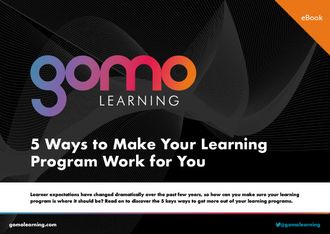For many learning and development teams, the majority of eLearning content and personal development interventions will eventually find their way onto a learning management system (LMS). An LMS is one of the most popular ways of hosting eLearning content, it gives students and learners a central place to go for their development needs, while the back end of things allows technical teams and L&D people to do their thing.
A recent report on the learning management system market by SoftwareAdvice.com highlights the popularity of mixing in-house eLearning builds with third-party, vendor lead eLearning content.
73% of LMS users employ a mix of in-house and third-party training content, which gives an interesting insight into how modern organizations are dealing with the build and learning, and development. As an eLearning authoring tool, we understand that it’s a bit much to ask of HR/ L&D teams to build and service a whole organization’s learning strategy. On the other hand, the cost of outsourcing all eLearning strategy and content is going to get expensive quickly, so it certainly makes sense to divide up where your content comes from.
Why mixing in-house and vendor-led eLearning content is great
Firstly, let's consider the benefits of the two approaches:
In-house eLearning content benefits
- Complete creative control
- Easily edited and updated
- Cost-effective
Vendor-led eLearning content benefits
- Outside perspective
- Guaranteed, timely delivery
- Specialist skills (games, videos, animations)
Varying your content delivery can prove even more important when it comes to the cons of choosing between in-house and vendor-led content. For example, eLearning content built externally may focus on learning design more, but may miss company tone of voice or messaging. On the flip side, internal eLearning content may get too focused on company messaging, taking away from the purpose of the content itself.
As you can see, there’s no right or wrong - it’s a real balancing act. If done right, it means your organization will get the best of both worlds, blending the two forms.
But how do you know exactly what should be left to the vendors and what should take on internally? Even in mid-sized, stable organizations, learning and development budgets can remain tight year after year, so it’s important that budget is well utilized to serve the business regardless of what new challenges emerge throughout the year.
In order to even consider developing eLearning content in-house, you need to be able to evaluate what your staff need, and whether you have the means within your organization to create it. It’s important to be realistic and consider what your workers need - a half-hour course to cover changes in fire safety will be much more manageable and realistic than producing an entire induction process. There’s probably some input or consulting needed from a vendor needed with the larger stuff, but your organization should still be able to feed in with content and work alongside a vendor if that’s the route you want to go down.
If you plan on building eLearning content in-house, you need to be able to evaluate whether you have all the resources available so you don’t become unstuck midway through. If already on a tight budget, the last thing you want to do is let problems and shortcomings make you lose sight of end goals.
Internal eLearning content checklist
This is just a rough guide, but creating eLearning content internally works well when…
- You have all source materials… or you have a plan/ budget to commission them with
- You are constrained by budget and cannot afford the external costs of a vendor
- You have, or can create, a strong storyboard for sign-off
- You have the people on hand to build and project manage the course
- You have access to an authoring tool you know is up to the job
- You have the means/ platform in place to deliver it to your workforce
If you have the people to carry out the scope, build, and analysis of a course, there’s an argument for saving the video-led, gamified, or more interactive stuff for external vendors. As outlined above, there’s really no right and wrong here - what suits your organization is dependent on a load of factors - organizational priorities, headcount, L&D/ HR team available, budget… and the list goes on. It’s great to keep all options open and work alongside any vendors to make the most effective use of your budget while constantly improving the eLearning content available to your workforce.
